
Gall Adelgid
Encyclopedia
Gall adelgid refers to adelgid
species that produce gall
s in spruce trees
, conifer
species. Such galls can be produced by an infection
by Adelges cooleyi (Adelges is the genus
, and Adelgidae is the subfamily), a species of aphid
-like woolly
adelgids (order Homoptera
). These infect the new bud
s of native spruce trees (Cooley Spruce gall adelgid) in the foothills
of the Rocky Mountains in the spring. They also attack blue spruce
to a lesser degree. The parasite
completes two generation
s within the year. The parasite requires two different trees for its life cycle
, the second being the Rocky Mountain Douglas-fir
. They may also attack Sitka
, Engelmann
, or white spruce
. There are many different species of adelgids that produce different gales on different spruce species.

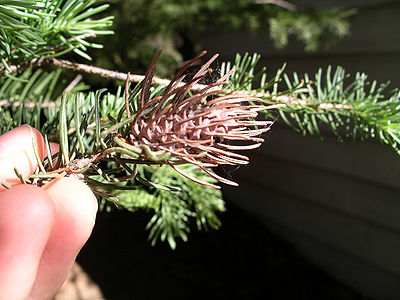

s which are used to penetrate into vascular bundles for feeding.
Once hatched, the young nymphs
begin feeding around the base of the needles in a new bud. The nymphs's saliva
introduced into the plant trigger the changes in development of the plant, distinguished by the thickening and expansion of the basal portion of needles towards the characteristic gall form. When there are incomplete infections, the side of the bud facing the ground will be infected first. Only partially afflicted buds can support new growth after the affected tissue has died.
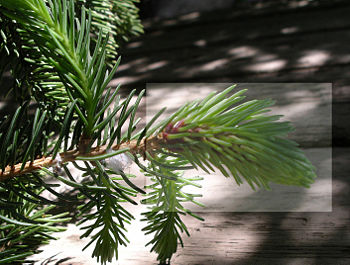
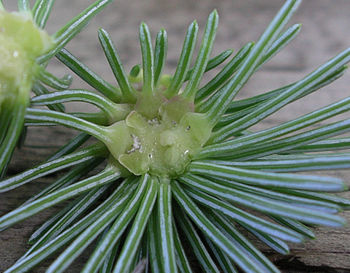 The chamber at the base of each needle is not connected with any other chamber in the gall. This differentiates this infection from that caused by the woolly adelgid genus Pineus, where in that case the chambers are interconnected.
The chamber at the base of each needle is not connected with any other chamber in the gall. This differentiates this infection from that caused by the woolly adelgid genus Pineus, where in that case the chambers are interconnected.  The nymphs are light brown when first hatched, becoming black when settled in gall chamber; they are flattened oval in shape and secrete a fringe of white wax. If a gall is opened in June, this white wax will be easily visible.
The nymphs are light brown when first hatched, becoming black when settled in gall chamber; they are flattened oval in shape and secrete a fringe of white wax. If a gall is opened in June, this white wax will be easily visible.
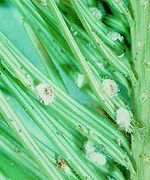 While the chambers of the galls are closed, the nymphs actively feed and increase in size. By midsummer (August to September), the galls begin to dry out, the chambers open and winged forms of the adelgids emerge. These winged adult females have dark red-brown colour, with a heavily sclerotized thorax
While the chambers of the galls are closed, the nymphs actively feed and increase in size. By midsummer (August to September), the galls begin to dry out, the chambers open and winged forms of the adelgids emerge. These winged adult females have dark red-brown colour, with a heavily sclerotized thorax
.,
These leave the original tree and most migrate to Douglas-fir trees. The abandoned galls continue to dry out and harden as the plant tissue dies. These dead galls are remnants that are never used again. The gall portion of partial infections dies, while the uninfected segment can continue growth, resulting in curved and convoluted shapes.

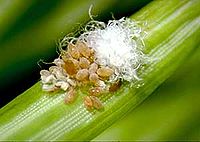 On Douglas-fir, eggs are laid on the needles and several generations of woolly adelgids are produced. Yellow spots and bent needles result from feeding damage. The needles of light to moderately infested trees exhibit chlorotic mottling where individual adults have fed. Attacked needles may also be twisted. Severely infested foliage may be completely chlorotic and drop prematurely. Late in the summer, some of the woolly adelgids develop wings and fly back to spruce to deposit eggs, which produce the overwintering population. Others are wingless and remain on Douglas-Fir trees, where they produce other overwintering forms.
On Douglas-fir, eggs are laid on the needles and several generations of woolly adelgids are produced. Yellow spots and bent needles result from feeding damage. The needles of light to moderately infested trees exhibit chlorotic mottling where individual adults have fed. Attacked needles may also be twisted. Severely infested foliage may be completely chlorotic and drop prematurely. Late in the summer, some of the woolly adelgids develop wings and fly back to spruce to deposit eggs, which produce the overwintering population. Others are wingless and remain on Douglas-Fir trees, where they produce other overwintering forms.
, hoverfly and lacewing larva
e, spider
s and mites
do reduce adelgid and aphid populations to some degree.
Spraying against these adelgids with chemicals is possible, and can be done in either the fall or the early spring. Foliar treatments of carbaryl (Sevin) and permethrin have been most effective in Colorado State University trials. Horticultural oils, which have also been very effective, can cause temporary discoloration of spruce needles.
The most commonly occurring aphids locally, in the Canadian Rocky Mountains, are several species of giant conifer aphids of the genus Cinara, and the Cooley spruce gall aphid Adelges cooleyi. Other aphids that have been pests are the green spruce aphid, Elatobium abietinum; the primitive woolly aphid, Mindarus obliquus; and two conifer root aphids, Pachypappa tremulae and Prociphilus xyloster. The balsam woolly aphid, Adelges piceae (also known as the balsam woolly adelgid), although a concern because of quarantine regulations, has not been reported at any local nurseries.
The coniferous root aphid, Pachypappa tremulae, previously called Rhizomaria piceae, has been a pest at several British Columbia nurseries, particularly near Prince George. This aphid has taken advantage of potted seedlings.
The balsam woolly aphid has become established in British Columbia and can seriously damage all true firs. Quarantines have to be respected to prevent its spread.
More on the invasive
woolly aphid species:
A University of Minnesota Pamphlet with image of mature woolly adelgid female:
http://www.entomology.umn.edu/cues/Web/098CooleySpruceGallAdelgid.pdf and related pests
Adelgidae
The Adelgidae is a small family of the Homoptera closely related to the aphids, and often traditionally included in the Aphidoidea with the Phylloxeridae. Adelgids are often known as "woolly conifer aphids". The family is composed of species associated with pine spruce or other conifers, known...
species that produce gall
Gall
Galls or cecidia are outgrowths on the surface of lifeforms caused by invasion by other lifeforms, such as parasites or bacterial infection. Plant galls are abnormal outgrowths of plant tissues and can be caused by various parasites, from fungi and bacteria, to insects and mites...
s in spruce trees
Spruce
A spruce is a tree of the genus Picea , a genus of about 35 species of coniferous evergreen trees in the Family Pinaceae, found in the northern temperate and boreal regions of the earth. Spruces are large trees, from tall when mature, and can be distinguished by their whorled branches and conical...
, conifer
Pinophyta
The conifers, division Pinophyta, also known as division Coniferophyta or Coniferae, are one of 13 or 14 division level taxa within the Kingdom Plantae. Pinophytes are gymnosperms. They are cone-bearing seed plants with vascular tissue; all extant conifers are woody plants, the great majority being...
species. Such galls can be produced by an infection
Infection
An infection is the colonization of a host organism by parasite species. Infecting parasites seek to use the host's resources to reproduce, often resulting in disease...
by Adelges cooleyi (Adelges is the genus
Genus
In biology, a genus is a low-level taxonomic rank used in the biological classification of living and fossil organisms, which is an example of definition by genus and differentia...
, and Adelgidae is the subfamily), a species of aphid
Aphid
Aphids, also known as plant lice and in Britain and the Commonwealth as greenflies, blackflies or whiteflies, are small sap sucking insects, and members of the superfamily Aphidoidea. Aphids are among the most destructive insect pests on cultivated plants in temperate regions...
-like woolly
Eriosomatidae
Woolly aphids are sucking insects that live on plant fluids, and produces a filamentous waxy white covering which resembles cotton or wool. The adults are winged and move to new locations where they lay egg masses. The larvae often form large cottony masses on twigs, for protection from predators...
adelgids (order Homoptera
Homoptera
Homoptera is a deprecated suborder of order Hemiptera; recent morphological studies and DNA analysis strongly suggests that the order is paraphyletic. It was therefore split into the suborders Sternorrhyncha, Auchenorrhyncha, and Coleorrhyncha....
). These infect the new bud
Bud
In botany, a bud is an undeveloped or embryonic shoot and normally occurs in the axil of a leaf or at the tip of the stem. Once formed, a bud may remain for some time in a dormant condition, or it may form a shoot immediately. Buds may be specialized to develop flowers or short shoots, or may have...
s of native spruce trees (Cooley Spruce gall adelgid) in the foothills
Foothills
Foothills are geographically defined as gradual increases in elevation at the base of a mountain range. They are a transition zone between plains and low relief hills to the adjacent topographically high mountains.-Examples:...
of the Rocky Mountains in the spring. They also attack blue spruce
Blue Spruce
Picea pungens is a species of spruce native to western North America, from southeast Idaho and southwest Wyoming, south through Utah and Colorado to Arizona and New Mexico. It grows at high altitudes from altitude, though unlike Engelmann Spruce in the same area, it does not reach the alpine...
to a lesser degree. The parasite
Parasitism
Parasitism is a type of symbiotic relationship between organisms of different species where one organism, the parasite, benefits at the expense of the other, the host. Traditionally parasite referred to organisms with lifestages that needed more than one host . These are now called macroparasites...
completes two generation
Generation
Generation , also known as procreation in biological sciences, is the act of producing offspring....
s within the year. The parasite requires two different trees for its life cycle
Biological life cycle
A life cycle is a period involving all different generations of a species succeeding each other through means of reproduction, whether through asexual reproduction or sexual reproduction...
, the second being the Rocky Mountain Douglas-fir
Rocky Mountain Douglas-fir
The Rocky Mountain Douglas-fir, Pseudotsuga menziesii subsp. glauca, is an evergreen conifer native to the interior mountainous regions of western North America, from central British Columbia and southwest Alberta in Canada southward through the United States to the far north of Mexico...
. They may also attack Sitka
Sitka Spruce
Picea sitchensis, the Sitka Spruce, is a large coniferous evergreen tree growing to 50–70 m tall, exceptionally to 95 m tall, and with a trunk diameter of up to 5 m, exceptionally to 6–7 m diameter...
, Engelmann
Engelmann Spruce
Picea engelmannii is a species of spruce native to western North America, from central British Columbia and southwest Alberta, southwest to northern California and southeast to Arizona and New Mexico; there are also two isolated populations in northern Mexico...
, or white spruce
White Spruce
Picea glauca is a species of spruce native to boreal forests in the north of North America, from central Alaska east to Newfoundland, and south to northern Montana, Minnesota, Wisconsin, Michigan, upstate New York, Vermont, New Hampshire, and Maine; there is also an isolated population in the...
. There are many different species of adelgids that produce different gales on different spruce species.
Identification
The infection is most noticeable on Cooley Spruce in the spring, May to June, when the galls appear. This infection may be mistakenly diagnosed to as caused by worms, grubs, or even as a sex organ of the spruce. Spruce pollen, however is released from a smaller structure that lacks needles. The galls are characterized by this pineapple-like form, with a length of 0.5 cm to 8 cm depending on the growth capacity of the tree. Most galls take on a pink, red or even deep purple colour while the needles usually remain green. The segments of the new bud that have this gall form will die after the aphids leave in the summer. Once on Douglas-fir, the adelgids consume the needles but do not form galls.


Infection
In the fall, the immature female adelgid, small, globular, and wingless (1.2-1.7 mm), finds a spruce to over-winter on. In the spring when the winter thaw occurs, the female matures and lays some eggs in what resemble sacks (totalling several hundred eggs) on the branches near the developing buds. These in fact are not sacks, but individual tufts of white waxy threads that protect the eggs. The females prefer areas on the spruce where they have greater protection from the elements, especially wind. These female individuals have an obvious patch of white wax wool as a covering. Their mouthparts consist of thread-like styletStylet
A stylet is a hard, sharp, anatomical structure found in some invertebrates.For example, the word stylet or stomatostyle, is used for the primitive piercing mouthparts of some nematodes and some nemerteans...
s which are used to penetrate into vascular bundles for feeding.
Once hatched, the young nymphs
Nymph (biology)
In biology, a nymph is the immature form of some invertebrates, particularly insects, which undergoes gradual metamorphosis before reaching its adult stage. Unlike a typical larva, a nymph's overall form already resembles that of the adult. In addition, while a nymph moults it never enters a...
begin feeding around the base of the needles in a new bud. The nymphs's saliva
Saliva
Saliva , referred to in various contexts as spit, spittle, drivel, drool, or slobber, is the watery substance produced in the mouths of humans and most other animals. Saliva is a component of oral fluid. In mammals, saliva is produced in and secreted from the three pairs of major salivary glands,...
introduced into the plant trigger the changes in development of the plant, distinguished by the thickening and expansion of the basal portion of needles towards the characteristic gall form. When there are incomplete infections, the side of the bud facing the ground will be infected first. Only partially afflicted buds can support new growth after the affected tissue has died.



Life cycle
The life cycle of the gall adelgid requires six generations to complete, only two of which cause damage (nymph stages) and has two migration phases between the spruce and the Douglas-fir. On Douglas-fir, adults are about 0.1 cm long, oval, and light to dark brown in colour. At maturity they are completely covered with white, waxy wool and appear, from spring to fall, as stationary wool tufts on the underside of needles.
Mesothorax
The mesothorax is the middle of the three segments in the thorax of an insect, and bears the second pair of legs. Its principal sclerites are the mesonotum , the mesosternum , and the mesopleuron on each side...
.,
These leave the original tree and most migrate to Douglas-fir trees. The abandoned galls continue to dry out and harden as the plant tissue dies. These dead galls are remnants that are never used again. The gall portion of partial infections dies, while the uninfected segment can continue growth, resulting in curved and convoluted shapes.


Predation and control
Natural predators, such as ladybirds/ladybugsCoccinellidae
Coccinellidae is a family of beetles, known variously as ladybirds , or ladybugs . Scientists increasingly prefer the names ladybird beetles or lady beetles as these insects are not true bugs...
, hoverfly and lacewing larva
Larva
A larva is a distinct juvenile form many animals undergo before metamorphosis into adults. Animals with indirect development such as insects, amphibians, or cnidarians typically have a larval phase of their life cycle...
e, spider
Spider
Spiders are air-breathing arthropods that have eight legs, and chelicerae with fangs that inject venom. They are the largest order of arachnids and rank seventh in total species diversity among all other groups of organisms...
s and mites
MITES
MITES, or Minority Introduction to Engineering and Science, is a highly selective six-week summer program for rising high school seniors held at the Massachusetts Institute of Technology. Its purpose is to expose students from minority, or otherwise disadvantaged backgrounds, to the fields of...
do reduce adelgid and aphid populations to some degree.
Spraying against these adelgids with chemicals is possible, and can be done in either the fall or the early spring. Foliar treatments of carbaryl (Sevin) and permethrin have been most effective in Colorado State University trials. Horticultural oils, which have also been very effective, can cause temporary discoloration of spruce needles.
Conifer aphids
Young trees that are large enough or having enough shade are most vulnerable to infection by aphids, such as Adelges cooleyi. Mature trees are more resistant.The most commonly occurring aphids locally, in the Canadian Rocky Mountains, are several species of giant conifer aphids of the genus Cinara, and the Cooley spruce gall aphid Adelges cooleyi. Other aphids that have been pests are the green spruce aphid, Elatobium abietinum; the primitive woolly aphid, Mindarus obliquus; and two conifer root aphids, Pachypappa tremulae and Prociphilus xyloster. The balsam woolly aphid, Adelges piceae (also known as the balsam woolly adelgid), although a concern because of quarantine regulations, has not been reported at any local nurseries.
The coniferous root aphid, Pachypappa tremulae, previously called Rhizomaria piceae, has been a pest at several British Columbia nurseries, particularly near Prince George. This aphid has taken advantage of potted seedlings.
The balsam woolly aphid has become established in British Columbia and can seriously damage all true firs. Quarantines have to be respected to prevent its spread.
See also
- Hemlock woolly adelgidHemlock Woolly AdelgidHemlock woolly adelgid , commonly abbreviated as HWA, is a true bug native to East Asia that feeds by sucking sap from hemlock trees . In eastern North America, it is a destructive pest that poses a major threat to the eastern hemlock and the Carolina hemlock...
: another disease caused by a woolly adelgid species. - Balsam woolly adelgidBalsam woolly adelgidBalsam woolly adelgids are small wingless insects that infest and kill firs, especially Balsam Fir and Fraser Fir. They are an invasive species from Europe introduced to the United States around 1900....
: another species of woolly adelgid.
More on the invasive
Invasive species
"Invasive species", or invasive exotics, is a nomenclature term and categorization phrase used for flora and fauna, and for specific restoration-preservation processes in native habitats, with several definitions....
woolly aphid species:
- Forest Pests. (2005). Balsam woolly aphid Adelges piceae (Ratzeburg). (World Wide Web page). Available: http://www.forestpests.org/southern/balsamwoollyadelgid.html (Dec. 1, 2005)
A University of Minnesota Pamphlet with image of mature woolly adelgid female:
http://www.entomology.umn.edu/cues/Web/098CooleySpruceGallAdelgid.pdf and related pests

